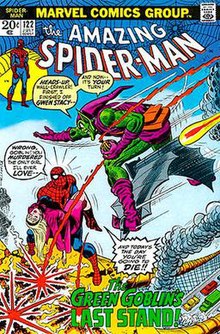Bronze Age of Comics
| Bronze Age of Comic Books | |
|---|---|

Amazing Spider-Man #122 (July 1973) The deaths of the Green Goblin and Gwen Stacy, cover art by John Romita, Sr.
|
|
| Time span | c. 1970 – c. 1985 |
| Related periods | |
| Preceded by | Silver Age of Comic Books (1956 – c. 1970) |
| Followed by | Modern Age of Comic Books (c. 1985 – present) |
The Bronze Age of Comic Books is an informal name for a period in the history of mainstream American comic books usually said to run from 1970 to 1985. It follows the Silver Age of Comic Books, and is followed by the Modern Age of Comic Books.
The Bronze Age retained many of the conventions of the Silver Age, with traditional superhero titles remaining the mainstay of the industry. However, a return of darker plot elements and more socially relevant storylines (akin to those found in the Golden Age of Comic Books) featuring real-world issues, such as racism, drug use, alcoholism, urban poverty, and environmental pollution, began to flourish during the period, prefiguring the later Modern Age of Comic Books.
There is no one single event that can be said to herald the beginning of the Bronze Age. Instead a number of events at the beginning of the 1970s, taken together, can be seen as a shift away from the tone of comics in the previous decade.
One such event was the April 1970 issue of Green Lantern, which added Green Arrow as a title character. The series, written by Denny O'Neil and penciled by Neal Adams (inking was by Adams or Dick Giordano), focused on "relevance" as Green Lantern was exposed to poverty and experienced self-doubt.
Later in 1970, Jack Kirby left Marvel Comics, ending arguably the most important creative partnership of the Silver Age (with Stan Lee). Kirby then turned to DC, where he created The Fourth World series of titles starting with Superman's Pal Jimmy Olsen #133 in December 1970. Also in 1970 Mort Weisinger, the long term editor of the various Superman titles, retired to be replaced by Julius Schwartz. Schwartz set about toning down some of the more fanciful aspects of the Weisinger era, removing most Kryptonite from continuity and scaling back Superman's nigh-infinite—by then—powers, which was done by veteran Superman artist Curt Swan together with ground-breaking author Denny O'Neil.
...
Wikipedia
